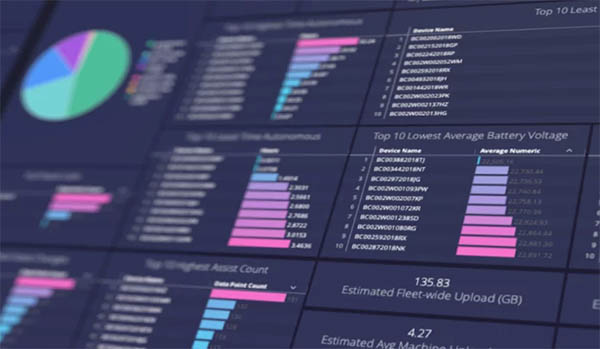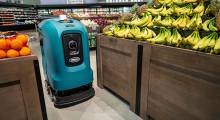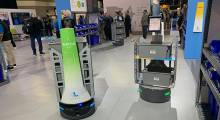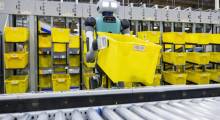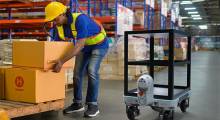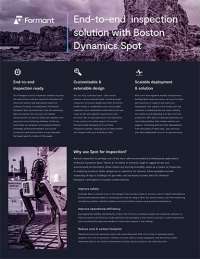Formant Inc. today announced that it has completed an $18 million Series A funding round. The San Francisco-based provider of technology for managing hetereogeneous fleets of robots said it plans to use the investment to continue its growth nationwide.
Founded in 2017, the company said its cloud-based platform enables companies to operate, observe, and analyze robots from anywhere, meeting the growing need of robotics companies looking to scale their fleets.
“We're striving to provide an essential platform can extend and accelerate development,” Jeff Linnell, founder and CEO of Formant, told Robotics 24/7.
Linnell recognizes robotics needs
While leading robot-infused creative studio Bot & Dolly, Linnell saw the need for better fleet management tools. “The more I saw robots deployed in the real world, the more it became clear that companies needed a single platform where they could manage all their devices,” he said.

Bot & Dolly was eventually acquired by Google, and after serving as head of product for Google’s robotics division, Linnell teamed up with robotics veterans from Savioke and Redwood Robotics to found Formant.
“We quickly found that every robotics company is unique,” he said. “So in addition to our core functionality, we also invested early on in APIs [application programming interfaces] to make Formant’s platform extensible and to empower customers to build custom apps inside Formant, using our data and infrastructure.”
Formant offers robotics infrastructure
Formant has also clarified its self-image. “From the perspective of where we've been and where we're going—a year ago, people saw us as robot command-center software,” recalled Linnell. “We also talk about teleoperation and observation.”
“We're building tooling on top of Formant to suit specific applications and workloads,” he said. “We think of ourselves more as an automation accelerant rather than a shrink-wrapped solution.”
In addition to its open architecture, Formant provides tools for workflows and autonomy, including data piping for authentication and user management.
“People usually come to us with different requirements—the operations person and billing will use different parts of our product,” said Linnell. “We're proud of our interfaces and workflows. They're battle-tested and look good from a design sensibility, and we're doing things like user interface toolkits. We're also compliant with MassRobotics' AMR [autonomous mobile robot] interoperability standard.”
“Formant provides all the components needed to build a solution 10 times faster than if doing it yourself,” he explained. “Our customers get excited about our APIs and building their own applications in Formant, since the world is moving too fast, and no one company can solve every problem.”
Users benefit from data, acceleration
Formant said its customers, which range in size from early-stage robotics startups to Fortune 100s, are using robots to tackle dirty, dangerous, and dull jobs in agriculture, energy, and other industries.
Blue River is using Formant to capture and process data generated by agricultural machinery out in the field. “We’re using robotics and machine learning to solve monumental challenges for our customers,” stated Ugur Oezdemir, senior manager of robotics at the John Deere subsidiary. “Formant provides us with a scalable back end to help process data from devices and make faster decisions.”
Formant can also help robotics startups bring products to market faster.
“Formant has been crucial for scaling our robotics company,” said Charlie Andersen, founder and CEO of Burro, which recently raised funding for its autonomous farming carts. “The people we sell to want to have 5,000 robots running around their fields — and they want to sit in a room and see them on a screen. This is where the world is headed right now, and Formant is helping us make that a reality.”
Investors interested in more robots
SignalFire led Formant's Series A funding, with participation from Hillsven, Pelion, Goodyear Ventures, Thursday Ventures, Ericsson, Picus Capital, and Holman Strategic Ventures.
“Our Series A round was oversubscribed, and we've been a nested bet,” said Linnell. “We're assuming that robotics as a service [RaaS] will succeed and that companies will need us.”
“Our platform is more complicated than TikTok, but there has been tremendous interest from strategic partners rather than traditional venture capital firms,” he noted. “We'll expand our network radically through new partners.”
“For instance, Goodyear has realized that the future of transport is not just cars and trucks,” Linnell said. “It's interested in the autonomous space and is involved with robots.”
“Ericcson is interested is interested in electronics and telematics for fleet vehicles, and as we get video and lidar in the cloud, Formant is arguably the hungriest company on Earth,” he added. “As 5G private networks start to get rolled out in environments like hospitals, it will be better than Wi-Fi.”
“Holman finances large deployments for FedEx and others,” said Linnell. “We're already starting to make lots of introductions, and we're exited [about] whom we ended up with.”
Formant plans to double in 2022
Formant plans to use its latest funding to double in size this year and to work on serving existing customers and acquiring new ones.
“We have 20 employees, with offices in San Francisco and Pittsburgh, and we'll add 20 more,” Linnell said. “We've partnered with MassRobotics and are looking to have a presence in Cambridge, Mass.”
What are some of the differences between the West Coast and East Coast robotics communities?
“On the West Coast, startups are venture-backed, while East Coast companies have academic, industrial, or DARPA grants,” replied Linnell. “There's a different mentality and more of a hardware focus on the East Coast.”
“On the West Coast, the focus with RaaS is on getting robots out into the field and doing production work, and in Boston, companies are focused on getting the hardware engineering right, but they're not yet aware of what Formant can bring as they scale,” he added. “It's still a technical sale as we educate and support customers on the platform.”
Collaborating for data, hardware
“In 2021, the world figured out that fleet management was a thing. It needed the glue to pull together operations,” Linnell said. “At the same time, we want to stick with what we're best at—we're the fastest way to stand up a robotic business.”
“We partner everywhere we can by vertical market,” he said. “Inspection requires different machine learning and localization schemes than a warehouse, and requirements for autonomous pallet jacks are radically different than for drones. Sometimes Formant provides the tools; other times, we have relationships with third-party data and hardware providers.”
“Half of our challenge for 2022 is not building features we shouldn't be doing, like the navigation stack or manipulation,” noted Linnell. “We partnered with PickNik Robotics for mobile manipulation, making it dead simple for users to check a box.”
Interest growing in field robotics
“We're seeing a lot of interest in agriculture, which has a severe labor shortage, semistructured environments, and the mechanics are relatively solved,” said Linnell. “We're working with folks like John Deere and a whole bunch of startups, as fleets double and triple. We're changing the ratio from one person behind a robot to one farmer in a truck managing four and eventally one person in Kentucky managing 100 robots in California.”
How does Formant's system work in areas without 5G or even Wi-Fi like fields or with closed networks, like hospitals?
“We've taken our cloud offering to make Formant work locally,” Linnell replied. “We wanted to avoid the edge but found ourselves pushed back down. There are reasons to do some things at the edge, such as weak networks, security, and cost.”
Other field robotics applications for Formant include infrastructure inspection, energy, and utilities, as well as delivery robots, disaster recovery, and autonomous trucking, said Linnell.
“I always thought of a robot operator as an odd job, but it's far more likely in 2022,” he said. “We're starting to see large companies starting to work with hardware from multiple vendors, such as an inspection drone followed by a quadruped robot. They're trying to combine data from aerial, terrestrial, and human sources into one piece of glass for informed decisions.”
“Predictive maintenance is a huge use case for us, but the question when you get to IoT [the Internet of Things] is where to go in the stack,” Linnell added. “We're data ingesters, getting the data so you can do things.”
“There's a tidal wave of data from autonomous systems pushing RaaS,” he said. “Formant can help companies continue their momentum.”
About the Author
Follow Robotics 24/7 on Linkedin
Article topics
Email Sign Up

